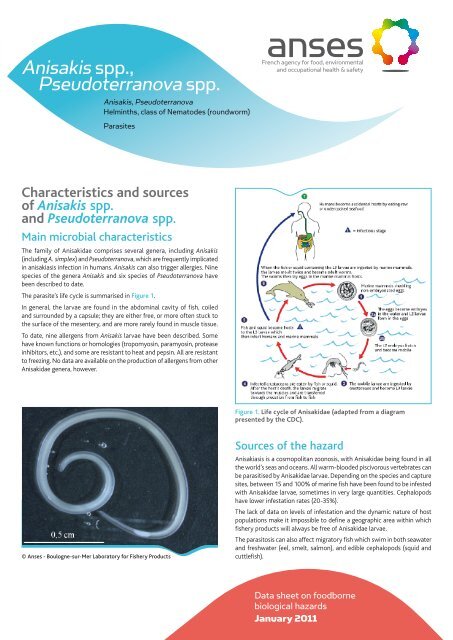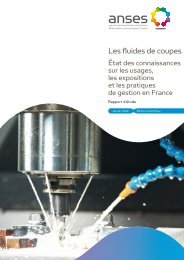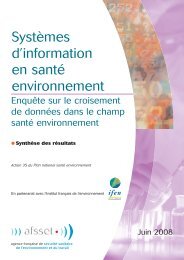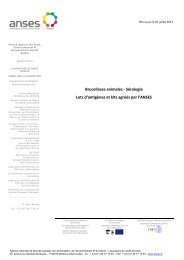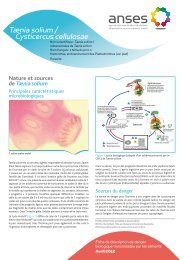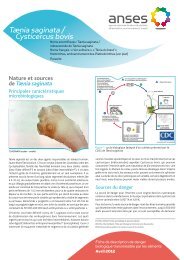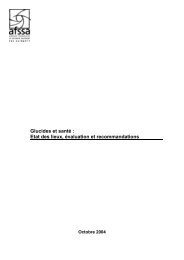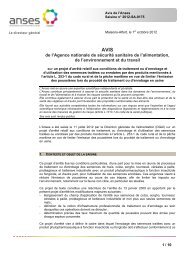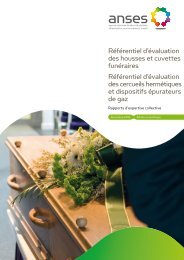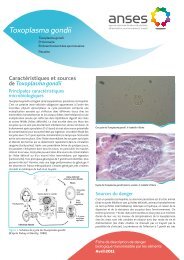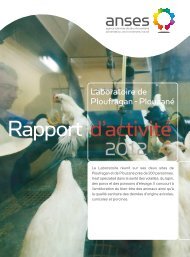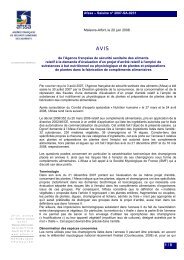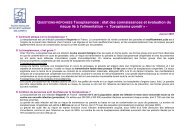Anisakisspp., Pseudoterranovaspp. - Anses
Anisakisspp., Pseudoterranovaspp. - Anses
Anisakisspp., Pseudoterranovaspp. - Anses
You also want an ePaper? Increase the reach of your titles
YUMPU automatically turns print PDFs into web optimized ePapers that Google loves.
Anisakis spp.,<br />
Pseudoterranova spp.<br />
Anisakis, Pseudoterranova<br />
Helminths, class of Nematodes (roundworm)<br />
Parasites<br />
Characteristics and sources<br />
of Anisakis spp.<br />
and Pseudoterranova spp.<br />
Main microbial characteristics<br />
The family of Anisakidae comprises several genera, including Anisakis<br />
(including A. simplex) and Pseudoterranova, which are frequently implicated<br />
in anisakiasis infection in humans. Anisakis can also trigger allergies. Nine<br />
species of the genera Anisakis and six species of Pseudoterranova have<br />
been described to date.<br />
The parasite’s life cycle is summarised in Figure 1.<br />
In general, the larvae are found in the abdominal cavity of fish, coiled<br />
and surrounded by a capsule; they are either free, or more often stuck to<br />
the surface of the mesentery, and are more rarely found in muscle tissue.<br />
To date, nine allergens from Anisakis larvae have been described. Some<br />
have known functions or homologies (tropomyosin, paramyosin, protease<br />
inhibitors, etc.), and some are resistant to heat and pepsin. All are resistant<br />
to freezing. No data are available on the production of allergens from other<br />
Anisakidae genera, however.<br />
Figure 1. Life cycle of Anisakidae (adapted from a diagram<br />
presented by the CDC).<br />
© <strong>Anses</strong> - Boulogne-sur-Mer Laboratory for Fishery Products<br />
Sources of the hazard<br />
Anisakiasis is a cosmopolitan zoonosis, with Anisakidae being found in all<br />
the world’s seas and oceans. All warm-blooded piscivorous vertebrates can<br />
be parasitised by Anisakidae larvae. Depending on the species and capture<br />
sites, between 15 and 100% of marine fish have been found to be infested<br />
with Anisakidae larvae, sometimes in very large quantities. Cephalopods<br />
have lower infestation rates (20-35%).<br />
The lack of data on levels of infestation and the dynamic nature of host<br />
populations make it impossible to define a geographic area within which<br />
fishery products will always be free of Anisakidae larvae.<br />
The parasitosis can also affect migratory fish which swim in both seawater<br />
and freshwater (eel, smelt, salmon), and edible cephalopods (squid and<br />
cuttlefish).<br />
Data sheet on foodborne<br />
biological hazards<br />
January 2011
The probability of Anisakidae infesting farmed fish (salmon in particular),<br />
when their diet is controlled, is considered as zero to near-zero.<br />
Lesions and diseases in fish vary depending on the intensity of the<br />
infestation and on the species (host and parasite). The main manifestations<br />
are overloading of the abdominal cavity, localised mechanical compression<br />
of tissues and the formation of granulomas around the parasite (sometimes<br />
causing its death). Anisakis larvae are mainly located in the abdominal<br />
cavity, whereas those of Pseudoterranova tend to be found in muscles.<br />
Transmission routes<br />
Transmission to humans is almost exclusively via food. Consumption of<br />
raw or undercooked fish is responsible for infestation. Some rare cases of<br />
non-food allergies, from direct contact with infected animals, have also<br />
been observed.<br />
Recommendations for primary production<br />
• All wild marine fish species should be considered as<br />
potentially contaminated, since due to a lack of information,<br />
no geographical area is known to be free of parasites.<br />
• In marine and inland aquaculture, diet should be controlled<br />
(only use feed made from compound feedingstuffs)<br />
throughout the life cycle, beginning from the egg stage, to<br />
maintain a near-zero risk of infestation.<br />
Human foodborne illness<br />
Nature of the disease<br />
The clinical symptoms induced by different Anisakidae genera are broadly<br />
similar. The Table 1 below includes all the symptoms, but they may appear<br />
differently depending on the patient and location of the parasite.<br />
Susceptible population groups (1) : people with an inherited predisposition,<br />
in whom the repeated ingestion of Anisakidae larvae, including dead ones,<br />
can cause allergy and may even result in anaphylactic shock. Conversely,<br />
sensitisation of “naive” subjects to Anisakidae allergens only results in the<br />
presence of specific IgE antibodies. It is likely that sensitivity to Anisakis<br />
allergens is initiated by infection with a live larva. However, once this<br />
sensitivity has been acquired, allergic episodes may be triggered by a live<br />
larva or by the allergens alone (from dead larvae).<br />
Dose-effect (2) relationships<br />
The presence of one larva is sufficient to cause the syndromes described<br />
in the Table 1.<br />
Epidemiology<br />
There are over 2500 cases of anisakiasis per year in Japan, the most affected<br />
industrialised country. In the United States, the incidence is 10 cases per<br />
year. In Europe, the countries where anisakiasis is most commonly reported<br />
are Spain, Norway, the Netherlands and the United Kingdom. The exact<br />
incidence is difficult to establish, but seems to average fewer than 20<br />
cases per country per year. However in 2005, a total of over 30 cases was<br />
reported in Italy. In France, a report by the InVS in 2003 estimated the<br />
incidence at eight cases per year, using data from a study conducted in<br />
1985-1987.<br />
The phenomena of allergic anisakiasis and sensitisation to Anisakis<br />
allergens have been a growing concern since they were first described<br />
in the 1990s. Indeed, a prevalence of around 12.4% of patients with IgE<br />
antibodies specific to A. simplex has been observed in the Madrid area.<br />
A Spanish study has implicated Anisakis in 10% of anaphylactic shocks<br />
resulting from allergic reactions. Moreover, Anisakis is responsible for the<br />
majority of allergic reactions due to hidden allergens (allergens to date<br />
unidentified as major allergens by the regulations stipulating labelling<br />
provisions, or not declared on the product label).<br />
Role of food<br />
Main foods to consider<br />
Humans become infected by eating contaminated fish or cephalopods<br />
that are raw, undercooked or preserved in preparations low in salt or acetic<br />
acid. In infested fish, it has been shown that the number of larvae generally<br />
increases with age, and therefore in proportion to the size of the fish.<br />
In France, various surveys (1988, 1993, 1994) on infestation rates in<br />
the most frequently consumed commercial fish species have led to the<br />
discovery of infestation rates of around 80% for anchovies, 30% for<br />
mackerel, 70% for whiting, 90% for hake and 60% for horse mackerel.<br />
The various culinary preparations that may lead to contamination<br />
include sushi (raw fish), bottarga (made from dried or smoked fish eggs),<br />
rollmops (herrings marinated in white wine or vinegar), kippers (smoked<br />
fish), Tahitian fish or “ceviche” (fish marinated in lemon) and marinated<br />
anchovies.<br />
(1) Susceptible population group: people with a higher than average probability of developing<br />
symptoms of the disease, or severe forms of the disease, after exposure to a foodborne hazard<br />
[definition used for the ANSES data sheets].<br />
(2) The relationship between the dose (the amount of microbial cells ingested during a meal)<br />
and the effect on an individual<br />
Table 1. Disease characteristics<br />
Mean incubation<br />
period<br />
Main symptoms<br />
Duration<br />
of symptoms<br />
Duration<br />
of infectious<br />
period<br />
(shedding)<br />
Complications<br />
Asymptomatic<br />
forms<br />
From 1 to 12 hours<br />
Gastric (abdominal pain, nausea, vomiting<br />
and/or diarrhoea, pseudo-ulcerous manifestations)<br />
and/or*<br />
Several days to several<br />
weeks in chronic cases<br />
Not applicable<br />
Bowel obstruction<br />
Yes,<br />
No data available on<br />
proportions<br />
From 12 h to more<br />
than 5 days<br />
Intestinal (nausea, vomiting and/or diarrhoea,<br />
appendicular or peritoneal syndromes, rare colitis<br />
or ileitis forms )<br />
Several days to several<br />
weeks in chronic cases<br />
Not applicable<br />
Bowel obstruction<br />
Yes,<br />
No data available on<br />
proportions<br />
From a few hours<br />
to 24 h<br />
• Gastro-allergic anisakiasis (e.g. digestive allergies,<br />
hives) caused by live larvae<br />
• Skin allergies (hives (20%), angioedema)<br />
caused by live or dead larvae.<br />
1 day Not applicable<br />
20 to 60% of cases are<br />
severe (angioedema,<br />
anaphylactic shock<br />
which can be fatal).<br />
Yes,<br />
No data available on<br />
proportions<br />
* The symptoms are related to penetration by the larvae of the gastric and/or intestinal mucosa.<br />
2 Data sheet on foodborne biological hazards / Anisakis spp., Pseudoterranova spp.
Inactivation treatments in industrial environments<br />
The conditions described in Table 2 kill the Anisakis larvae, although this<br />
does not completely eliminate the risk of allergy in humans (persistence<br />
of allergens).<br />
Table 2. Inactivation treatments<br />
Effects of temperature<br />
Thorough cooking: >60°C core temperature, 1 minute; the FDA recommends reaching<br />
at least 70°C, if cooking in the microwave.<br />
For fillets 3 cm thick: 60°C, 10 min.<br />
Freezing: –20°C, 24h* (or) –35°C, 15h** (or) –15°C, 96h**.<br />
Chemical treatments***<br />
Treatment Parameters Product<br />
Salting, salting,<br />
NaCl at 8-9%, 6 weeks, dry salt, 20 days<br />
Herring<br />
cold smoking<br />
Marinating<br />
NaCl at 12% + acetic acid at 10%, 5 days.<br />
NaCl at 12% + acetic acid at 6%, 13 days at 4°C<br />
NaCl at 6% + acetic acid at 2.4%, 35 days<br />
NaCl at 10% + acetic acid at 6%, 24h then 4°C,<br />
13 days<br />
NaCl at 6.3% + acetic acid at 3.7%, 28 days<br />
Anchovy<br />
Sardine<br />
Herring<br />
* Regulation (EC) no. 853/2004 as amended.<br />
** American standards.<br />
*** These conditions, though effective, are not those typically used in current industrial<br />
processes but rather represent traditional and small-scale production.<br />
Monitoring in food<br />
In fishery products, the reference method for detecting larvae is a visual<br />
inspection of pieces, such as fillets, using transillumination. However, the<br />
efficacy of this method varies (7 to 75% of parasites detected) depending<br />
on the species of fish (darkness and density of the flesh) and the species<br />
of parasite (size and colour of larvae). The only existing document that<br />
describes a method for detecting parasites is a Codex Alimentarius standard<br />
on salted Atlantic herring and salted sprats (Codex Standard 244-2004).<br />
Recommendations to operators<br />
• Freezing and cooking are the most effective treatments for<br />
killing larvae of Anisakis and Pseudoterranova, under specific<br />
conditions. However, there is no control measure currently<br />
available to combat the risk of allergy.<br />
• Only certain traditional marinating or salting methods are<br />
sufficient to kill these larvae.<br />
• The efficacy of new combinations of inactivation treatments<br />
warrants evaluation.<br />
• Collective prophylaxis of anisakiasis is based on the<br />
principles laid down in Regulation EC No. 853/2004 of the<br />
European Parliament and of the Council of 29 April 2004:<br />
rapid refrigeration or processing (cutting, freezing) of fishery<br />
products, maintenance of the cold chain, visual inspection<br />
on site and/or in the laboratory of products released for<br />
consumption, prior freezing (–20°C, 24h at all points) of<br />
products intended to be consumed raw or inadequately<br />
processed (cold smoking, salting, marinating, etc.).<br />
• Any migration of larvae towards surrounding tissue (fillets)<br />
should be avoided by refrigerating and eviscerating the<br />
freshly caught fish as rapidly as possible (this reduces but<br />
does not eliminate the risk because larvae are also found<br />
encapsulated in the muscle of live fish).<br />
• In addition, although Anisakidae allergens are not among the<br />
major allergens identified by the regulations (3) , operators are<br />
nevertheless encouraged to consider labelling information.<br />
Domestic hygiene<br />
Recommendations to consumers<br />
• Individual prophylaxis of parasitism by Anisakidae<br />
larvae is based on thorough cooking of fresh sea fish. For<br />
raw fish eaters, freezing for 7 days in a home freezer is<br />
recommended. The rapid evisceration of fresh-caught fish<br />
is also recommended. Cutting fish into thin slices (carpaccio)<br />
rather than thick slices or cubes can help to detect possible<br />
parasites, but it should be noted that if an Anisakis larva<br />
is cut in two, the front half is still capable of penetrating<br />
the wall of the gastrointestinal tract.<br />
• There is no known measure for avoiding the risk of allergies,<br />
only refraining from consumption is recommended in cases<br />
of allergy.<br />
References and links<br />
• Center for Disease Control, Division of Parasitic Diseases - Anisakis<br />
Infection (USA)<br />
http://www.cdc.gov/ncidod/dpd/parasites/anisakis/default.htm<br />
• EFSA Panel on Biological Hazards (BIOHAZ); Scientific Opinion on risk<br />
assessment of parasites in fishery products. EFSA Journal 2010; 8(4):1543.<br />
[91 pp.]. doi:10.2903/j.efsa.2010.1543. www.efsa.europa.eu<br />
• European Union Reference Laboratory for Parasites (in particular<br />
Trichinella, Echinococcus and Anisakis), Istituto Superiore di Sanità (ISS),<br />
Viale Regina Elena 299, I-00161 Roma, Italy.<br />
• FAO - Assessment and Management of Seafood Safety and Quality:<br />
ftp://ftp.fao.org/docrep/fao/006/y4743e/y4743e00.pdf<br />
• InVS - Morbidité et mortalité dues aux maladies infectieuses d’origine<br />
alimentaire en France : http://www.invs.sante.fr/publications/2004/<br />
inf_origine_alimentaire/inf_origine_alimentaire.pdf<br />
• National Reference Laboratory for foodborne parasites, Maisons-Alfort<br />
laboratory for animal health, UMR BIPAR, ANSES, 23 avenue du général<br />
de Gaulle, 94706 Maisons-Alfort cedex.<br />
(3) French Consumer Code, Chapter II of Title I of Book I Article Annex IV, Modified by Ministerial<br />
Decree no. 2008-1153 of 7 November 2008 - art.<br />
3 Data sheet on foodborne biological hazards / Anisakis spp., Pseudoterranova spp.


